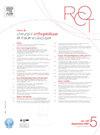Diagnostic et gestion des infections des tissus mous du membre supérieur
Q4 Medicine
Revue de Chirurgie Orthopedique et Traumatologique
Pub Date : 2025-09-15
DOI:10.1016/j.rcot.2025.06.010
引用次数: 0
Abstract
Les infections des parties molles sont fréquentes au membre supérieur, et particulièrement à la main, exposée à l’environnement. Elles regroupent des entités diverses dans leur gravité, leur évolutivité, et leur fréquence, mais elles ont en commun, en cas de mauvaise gestion, d’avoir un retentissement fonctionnel majeur, un risque d’amputation, voire un risque vital. Les germes en cause au membre supérieur sont majoritairement les cocci Gram+, mais les bacilles Gram− colonisent aussi les plaies par morsures qui sont fréquentes au membre supérieur. On distingue, des plus fréquentes et bénignes aux plus graves : les panaris, les infections non collectées-dermo-hypodermites bactériennes non nécrosantes (DHBNN), les collections suppurées (abcès) desquelles on rapproche les phlegmons des gaines des fléchisseurs, et les dermo-hypodermites bactériennes nécrosantes-fasciites nécrosantes (DHBN-FN). Le diagnostic clinique est basé sur l’érythème, le gonflement, la douleur, l’augmentation de la chaleur locale. Une lymphangite ou une adénopathie sont des signes d’envahissement régional. L’apparition d’une nécrose cutanée, ou d’un choc septique doit faire évoquer une DHBN-FN. La biologie retrouve une hyperleucocytose, une augmentation de la CRP et pour les infections invasives, parfois des perturbations du bilan hépatique ou rénal, une hyperlactatémie, signes de gravité. Le traitement des infections des parties molles du membre supérieur est médico-chirurgical. Il est médical seul par antibiothérapie en cas de DHBNN. La chirurgie est indispensable pour drainer une collection suppurée (phlegmon des gaines, abcès), ou pour exciser largement les tissus envahis dans le DHBN-FN, en plus d’une antibiothérapie probabiliste puis adaptée aux prélèvements. Après l’objectif initial d’éradication de l’infection, l’objectif final est de permettre la réhabilitation fonctionnelle du membre. Le traitement des infections des parties molles au membre supérieur est donc souvent pluridisciplinaire, associant chirurgiens, parfois réanimateurs, infectiologues, puis kinésithérapeutes.
Niveau de preuve
V : avis d’expert.
Soft tissue infections are common in the upper limb, and particularly in the hand, which is exposed to the environment. They include entities that are diverse in their severity, their progression, and their frequency. However, they have in common, in the event of poor management, that they have a major functional impact, amputation, or even a life-threatening risk. The germs involved in the upper limb are mainly Gram-positive cocci, but Gram-negative bacilli colonize bite wounds, which are common in the upper limb. From the most frequent and benign to the most serious, we distinguish: whitlows, non-collected infections – non-necrotizing bacterial dermohypodermitis (DHBNN), suppurative collections (abscesses) from which phlegmons of the flexor sheaths are associated, and necrotizing bacterial dermohypodermitis – necrotizing fasciitis (DHBN-FN). The clinical diagnosis is based on erythema, swelling, pain, increased local heat. Lymphangitis or adenopathy are signs of regional invasion. The appearance of skin necrosis or septic shock should suggest DHBN-FN. Biology finds hyperleukocytosis, an increase in CRP, for invasive infections, or even disturbances in the liver or kidney function tests, lactates, signs of severity. Imaging examinations are mainly X-rays in the case of a wound, ultrasound or CT scan. Treatment of infections of the soft parts of the upper limb is medical and surgical. It is medical alone by antibiotic therapy in the case of DHBNN. Surgery is essential to drain a suppurative collection (phlegmon of the sheaths, abscess), or to widely excise the invaded tissues in DHBN-FN, in addition to probabilistic antibiotic therapy then adapted to the samples. After the initial objective of eradicating the infection, the final objective is to allow the functional rehabilitation of the limb. The treatment of soft tissue infections in the upper limb is therefore often multidisciplinary, involving surgeons, sometimes resuscitators, infectiologists, and then physiotherapists.
Level of evidence
V: expert opinion.
上肢软组织感染的诊断与管理
软组织感染在暴露在环境中的上肢,特别是手部很常见。它们的严重性、进化性和频率各不相同,但如果管理不当,它们都有严重的功能影响、截肢甚至危及生命的风险。上肢的细菌主要是Gram+球虫,但Gram -细菌也会定植上肢常见的咬伤伤口。从最常见的良性到最严重的有:泛素、非聚集性感染——非坏死细菌皮下皮炎(DHBNN)、化脓性聚集性感染(脓肿),其中衣原体与flexissers的腺体接近,以及坏死细菌皮下皮炎——坏死筋膜炎(DHBN-FN)。临床诊断基于红斑、肿胀、疼痛和局部发热的增加。淋巴炎或腺病是局部侵袭的迹象。皮肤坏死或脓毒症休克应引起DHBN-FN。生物学发现白细胞增多,CRP增加,对于侵袭性感染,有时肝脏或肾脏平衡紊乱,乳酸增多,严重的迹象。上肢软组织感染的治疗是医学-外科。在DHBNN的情况下,它只能通过抗生素治疗。手术是必要的排水化脓性收集(套管粘液,脓肿),或广泛切除DHBN-FN中的入侵组织,除了可能的抗生素治疗,然后适应采集。在最初的目标是根除感染之后,最终的目标是使肢体功能恢复。因此,上肢软组织感染的治疗通常是多学科的,涉及外科医生,有时涉及复苏专家,传染病专家,然后是物理治疗师。证据级别V:专家意见。软组织感染在上肢很常见,尤其是暴露在环境中的手。它们包括在严重性、进展和频率上各不相同的实体。然而,在管理不善的情况下,他们通常会有重大的功能影响、截肢,甚至危及生命的风险。参与上肢的细菌主要是革兰氏阳性球菌,但革兰氏阴性杆菌定植咬伤,这在上肢很常见。从最常见、最温和的到最严重的,我们区分:白癜风、非收集性感染——非坏死性细菌性皮炎(DHBNN)、化脓性感染(脓肿)与柔毛鞘的衣原体有关,以及坏死性细菌性皮炎——坏死性筋膜炎(DHBN-FN)。临床诊断基于红斑、肿胀、疼痛、局部发热增加。淋巴管炎或腺病是区域侵袭的迹象。皮肤坏死或脓毒症休克的出现应提示DHBN-FN。研究人员发现,白细胞增多症,CRP的增加,用于侵袭性感染,甚至肝脏或肾脏功能测试、乳酸、严重的迹象。成像检查主要是伤口的x光、超声波或CT扫描。治疗感染of the soft parts of the upper limb is medical and手术。它是一种非甾体抗炎药。手术是必要的引流化脓性收集(痰,脓肿),或广泛切除侵入组织的DHBB -FN,除了可能的抗生素治疗,然后适应样本。在最初的目标是根除感染之后,最终的目标是允许肢体的功能康复。因此,上肢软组织感染的治疗通常是多学科的,涉及外科医生,有时涉及复活医生,传染病学家,然后是物理治疗师。证据水平V:专家意见。
本文章由计算机程序翻译,如有差异,请以英文原文为准。
求助全文
约1分钟内获得全文
求助全文
来源期刊

Revue de Chirurgie Orthopedique et Traumatologique
Medicine-Surgery
CiteScore
0.10
自引率
0.00%
发文量
301
期刊介绍:
A 118 ans, la Revue de Chirurgie orthopédique franchit, en 2009, une étape décisive dans son développement afin de renforcer la diffusion et la notoriété des publications francophones auprès des praticiens et chercheurs non-francophones. Les auteurs ayant leurs racines dans la francophonie trouveront ainsi une chance supplémentaire de voir reconnus les qualités et le intérêt de leurs recherches par le plus grand nombre.
 求助内容:
求助内容: 应助结果提醒方式:
应助结果提醒方式:


